Friday, September 08, 2006
Æ30, Side in Pamphylia, Valerian II, SNG Copenhagen 435
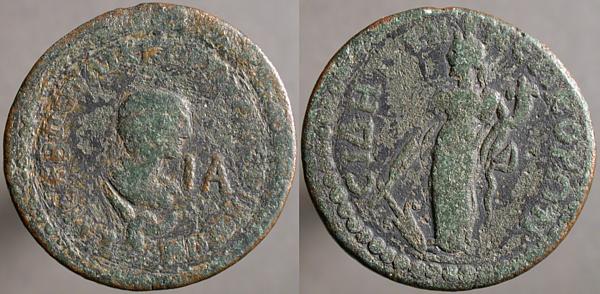
K[A]I C[E]B Π[OV] ΛIK KOPO VA[ΛEPIANO...], Bare-headed draped bust (of Valerian II) right over eagle with wings spread. IA before | CIΔHTΩN NEΩKOPΩN, Tyche standing left, holding rudder with right hand and cornucopia with left. Δ in right field.
Despite the very worn state of this coin, it's evenly worn and the portrait and the figure of Tyche are distinct.
I've heard from some people that the bust over eagle obverse may indicate that the die was prepared after the death of Valerian II, but since I have examples of the same motif with the portrait of Gallienus, and I don't accept any posthumous issues or for him, I think there is some other significance to the eagle which I can't explain.
A curious analogy is this bust over an arrow.
Thursday, September 07, 2006
Silvered Æ antoninianus, Gallienus, Cyzikus, Göbl 1535Bd
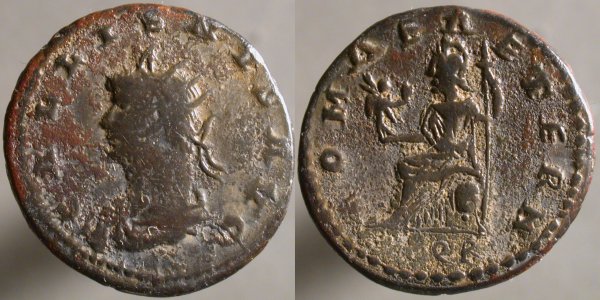
GALLIENVS AVG, Radiate draped cuirassed bust left, one pellet beneath | ROMAE AETERN, Roma seated left on gorgon-face shield, holding in right hand Victory presenting wreath left and in left hand spear. SPQR in exergue.
Because imperial coins of Gallienus minted at Cyzikus are quite uncommon, it's evident that they come onto the marked in waves. Sometimes they're from an old collection, and sometimes they have no such pedigree and are apparently being sold to collectors for the first time since they came out of the ground. Sometimes, more prosaically, they not related to each other, just a coincidence.
Because this coin has had significant encrustation, I'm not 100% certain about the number of pellets beneath the bust, which Cyzikus used to indicate which officina minted the coin. I believe there is a single pellet:

Göbl attests no examples of this reverse from any officina with left-facing busts.
Wednesday, September 06, 2006
Æ4, Gratian, Siscia, RIC 31a
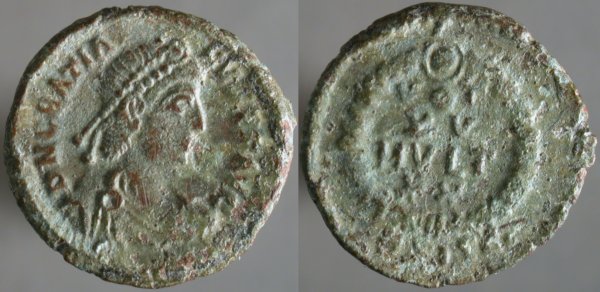
D N GRATIA_NVS P F AVG, Pearl-diademed draped cuirassed bust right | VOT / XV / MVLT / XX, Legend in four lines within wreath, BSISC· in exergue.
Flavius Gratianus Augustus was the son of Valentinian I and was made emperor by his father in 367.
Gratian was not a great military mind but avoided any hugely newsworthy until 383 when he battled the Alamanni and suffered enough losses that he was not able to answer the rise of the usurper Magnus Maximus. When Maximus and his army arrived in Gaul to confront Gratian Gratian's troops began defecting to Maximus and pursued Gratian when he fled the scene. They caught and assassinated him near Lyon August 25, 383.
Tuesday, September 05, 2006
Æ31, Synnada in Phrygia, Gallienus, SNG von Aulock 3995
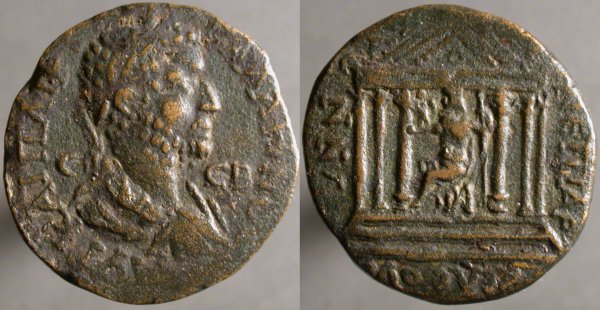
AV KAI Π ΛIK ΓAΛΛHNO / C_EB, Laureate draped cuirassed bust right, seen from behind | CVNN_A[Δ_EΩ_]N EΠI AP / KEΛCOV, Zeus seated left, holding eagle in right hand and sceptre in left, within hexastyle temple; wreath in pediment.
The distinctly positive thing is that this is my first coin from this city, today Schifout Kassaba in Turkey. There was, though, a second, similar, coin auctioned the same die which I didn't win. That coin, from the city of Prymnessus in Phrygia, was struck from the same obverse die as this.
I've long known that some sharing occurred between some cities, but it would have been rewarding to have physical proof.
Still, I bid the maximum I was willing to pay and when I saw my bid exceeded, I said farewell to that coin and I don't look back except in this post and I don't regret that someone wanted it $100 more than I did.
Monday, September 04, 2006
Silvered Æ antoninianus, Gallienus, Cyzikus, Göbl 1542Ac
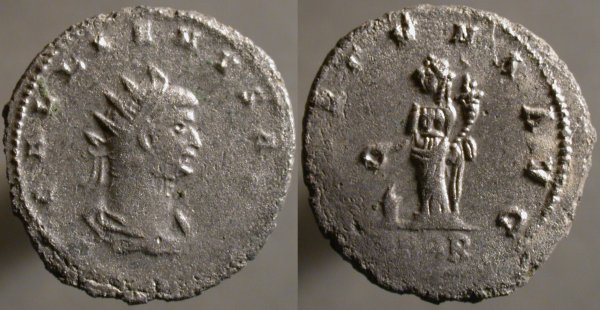
GALLIENVS AVG, Radiate draped cuirassed bust right | FORTVNA AVG, Fortuna standing left, holding cornucopia right, sacrificing from patera over flaming alter left. SPQR in exergue.
Last week's two Gallienus coins (here and here) were each attested by Göbl in only a single example. This coin, with this bust and no pellets beneath it, is mot attested as existing at all.
It seems that there were three officinae, or workshops, functioning at Cyzikus. Zero, one, or two pellets beneath the bust indicate which one produced a given coin. As coins with zero pellets predominate, I suspect this scheme was adopted some time after minting began, but I think Gallienus died not more than months after that beginning.
The issues from Cyzikus, all marked with SPQR in the exergue, remain the area of Gallienus coinage that could most benefit from additional scholarly attention.

